A differentially-methylated-region signature predicts the recurrence risk for patients with early stage lung adenocarcinoma
- PMID: 39560475
- PMCID: PMC11719112
- DOI: 10.18632/aging.206139
A differentially-methylated-region signature predicts the recurrence risk for patients with early stage lung adenocarcinoma
Abstract
Predicting prognosis in lung cancer patients is important in establishing future treatment and monitoring plans. Lung adenocarcinoma (LUAD) is the most common and aggressive type of lung cancer with dismal prognosis and prognostic stratification would help to guide treatment. Aberrant DNA methylation in tumors occurs earlier than clinical variations, and keeps accumulating as cancer progresses. Preliminary studies have given us some clues that DNA methylation might serve as a promising biomarker for prognosis prediction. Herein, we aimed to study the potential utility of DNA methylation pattern in predicting the recurrence risk of early stage resectable LUAD and to develop a risk-modeling signature based on differentially methylated regions (DMRs). This study consisted of three cohorts of 244 patients with stage I-IIIA LUAD, including marker discovery cohort (n = 39), prognostic model training cohort (n = 117) and validation cohort (n = 80). 468 DMRs between LUAD tumor and adjacent tissues were screened out in the marker discovery cohort (adjusted P < 0.05), and a prognostic signature was developed based on 15 DMRs significantly related to disease-free survival in early stage LUAD patients. The DMR signature showed commendable performance in predicting the recurrence risk of LUAD patients both in model training cohort (P < 0.001; HR = 4.32, 95% CI = 2.39-7.80) and model validation cohort (P = 0.009; HR = 9.08, 95% CI = 1.20-68.80), which might be of great utility both for understanding the molecular basis of LUAD relapse, providing risk stratification of patients, and establishing future monitoring plans.
Keywords: DNA methylation; lung adenocarcinoma; prognosis; recurrence.
Conflict of interest statement
Figures




Similar articles
-
Identification of a methylomics-associated nomogram for predicting overall survival of stage I-II lung adenocarcinoma.Sci Rep. 2021 May 11;11(1):9938. doi: 10.1038/s41598-021-89429-4. Sci Rep. 2021. PMID: 33976305 Free PMC article.
-
Unique metastasis-associated lncRNA signature optimizes prediction of tumor relapse in lung adenocarcinoma.Thorac Cancer. 2020 Mar;11(3):728-737. doi: 10.1111/1759-7714.13325. Epub 2020 Jan 28. Thorac Cancer. 2020. PMID: 31994347 Free PMC article.
-
Eight-gene signature predicts recurrence in lung adenocarcinoma.Cancer Biomark. 2020;28(4):447-457. doi: 10.3233/CBM-190329. Cancer Biomark. 2020. PMID: 32508318
-
Prognostic value of SEC61G in lung adenocarcinoma: a comprehensive study based on bioinformatics and in vitro validation.BMC Cancer. 2021 Nov 13;21(1):1216. doi: 10.1186/s12885-021-08957-4. BMC Cancer. 2021. PMID: 34774014 Free PMC article.
-
Novel genome-wide DNA methylation profiling reveals distinct epigenetic landscape, prognostic model and cellular composition of early-stage lung adenocarcinoma.J Transl Med. 2024 May 6;22(1):428. doi: 10.1186/s12967-024-05146-2. J Transl Med. 2024. PMID: 38711158 Free PMC article.
References
-
- Arriagada R, Bergman B, Dunant A, Le Chevalier T, Pignon JP, Vansteenkiste J, and International Adjuvant Lung Cancer Trial Collaborative Group. Cisplatin-based adjuvant chemotherapy in patients with completely resected non-small-cell lung cancer. N Engl J Med. 2004; 350:351–60. 10.1056/NEJMoa031644 - DOI - PubMed
MeSH terms
Substances
LinkOut - more resources
Full Text Sources
Medical

